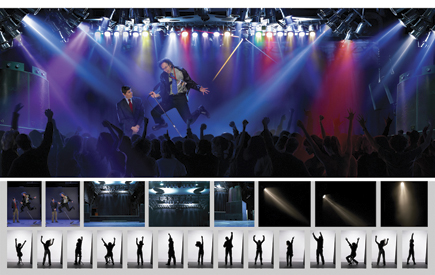Don Dixon’s Digital Doings; Convincing Composites
Don Dixon (www.dixonfilm.com) has always impressed me as the consummate professional. A contributor to two of my books, Studio Lighting Solutions and Location Lighting Solutions (Amphoto), he continues to produce a body of work that stands head and shoulders above many when it comes to originality. His digital composites never cease to amaze me with their technical perfection and attention to detail. And at times he even adds a humorous twist that flavors the shot just right.
Based in Toronto, Dixon has been a professional photographer for almost 30 years. He opened his studio together with Steve Mykolyn, but took over the reins not long afterward. This talented photographer surrounds himself with an equally talented staff, among them Luna Simic and Shereen Mroueh, his go-to team for digital composites and retouching in-house. In all, the staff at Don Dixon Film + Photography numbers nine people, helping with everything from studio management to production and lighting.
 |
|
|
Lighting For Two Worlds
Not too long ago, this intrepid shooter expanded into commercial video. In fact, we can often find Dixon setting up lights for motion and still side by side. “I use the hot lights when I’m shooting people in video, specifically Strand lights (www.strandlighting.com). I’ll also use them for product shots—to better see what I’m getting,” Dixon observes. He also uses ARRI tungsten lights (www.arri.com) and occasionally Kino Flo fluorescents (www.kinoflo.com).
Profoto strobes take center stage when it comes to lighting for portraiture, with a D4 system seeing constant use in the studio (www.profoto-usa.com). Outdoors and on location, Dixon turns to a Profoto Pro-7b battery-powered system. “And if I need extra power, I’ll rent,” Dixon adds.
In a manner of speaking, the Profotos took center stage on a recent assignment for the Kentucky World Convention Center. In one shot Dixon presents a cacophony of performers on stage in front of an audience. In another, the performance aspect is toned down, but the stage itself gives way to a raucous dance of stage lights. Neither scene is real.
 |
|
|
To create each shot, Dixon photographed and composited separate elements in the studio—almost all with the aid of his Profotos, of course. One element was captured on location: the stage lights, at a local music hall. But even here a key component was shot in the studio, namely the light beams, and without additional lighting. For these, he first attached a Mini Maglite flashlight (www.maglite.com) to a clamp, aiming the flashlight straight down. He added different color gels, as needed, but the real trick was capturing that beam. For that he was aided by canned fog (available online under different brand names), which was sprayed into the path of the light.
As for the performers, the only one who was a true performer and not simply playing a role was the contortionist (photographed in two different poses). The others were hired models. The audience was comprised of anyone who happened to be the studio, including Dixon himself. The stage itself was only 3-feet long and the curtains only a foot high—both props.
 |
|
 |
|
|
















































